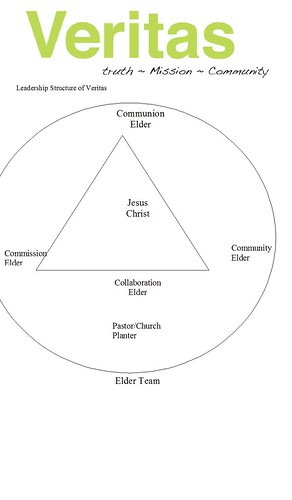Church Planting, Community, Leadership, Ministry Formation, Missional
Veritas Leadership Structure
So the last time that I wrote anything for Emergent Brethren I mentioned our Monthly Rhythm for our gatherings. I shared about our desire to live out (as individuals and as a community) the OUT, UP, IN 3 Dimensional life of a disciple of Jesus. As I began to do some more thinking about this triangle, our monthly rhythm and our core values, I also became aware that this triangle could guide how we structured the leadership of Veritas as we move forward. Below you’ll find a document that I have written to lay out what the Veritas Leadership Structure will look like taking into consideration our Core Values and our Monthly Rhythm. I would love to hear your thoughts, comments, ideas, etc……
Leadership Structure of Veritas

“Role Descriptions†of Elder Team (including the Church Planter/Pastor)
Commission Elder:
Vision: To see that we at Veritas serve and bless people in real and practical ways.
1. Partner with Pastor Ryan on planning OUT events, activities, and gatherings. (Getting Artists for 1st Friday, Musicians for 3rd Friday, connecting with Non-Profits to serve with, etc…)
2. Plan (with Pastor Ryan) the monthly OUT Sunday (currently 1x a month)
3. Train, meet, resource, and network with the Missional Communities OUT Leaders.
4. Develop ways, ideas, and dreams of getting OUT into the world and blessing it and means of getting the word out about Veritas.
5. Meet monthly with Pastor/Church Planter and Elder team.
Communion Elder:
Vision: To create regular opportunities of relevant worship experiences, not as consumers but participating in and creating the worship that is taking place, with people connecting worship on Sunday with their worship on Monday through Saturday.
1. Partner with Pastor Ryan on planning the Corporate UP Gatherings (2x a month), the sermon series planning, and what each Missional Community is “studying†during their UP Gatherings.
2. Train, meet, resource, and network with the Missional Communities UP leaders.
3. Develop in Partnership with Pastor Ryan a discipleship process for Veritas.
4. Creating, Overseeing, and working on teams that help the Corporate UP Gatherings come together. (Musical team, Children’s Ministry Team, Multimedia Team)
5. Meet monthly with Pastor/Church Planter and Elder team.
Community Elder:
Vision: To help Veritas become a community full of love, grace, compassion, and mercy, following in Jesus’ footsteps.
1. Partner with Pastor Ryan on planning IN events, activities and gatherings that strength the relational community.
2. Train, meet, resource and network with the Missional Communities IN Leaders.
3. Create, Oversee and work on a Hospitality Team for our Corporate UP Gatherings.
4. Plan (with Pastor Ryan) the monthly IN Sunday (currently 1x a Month)
5. Meet monthly with the Pastor/Church Planter and Elder team.
Collaboration Elder:
Vision: To see that Veritas honors and glories God in the areas of stewardship and strategic development.
1. Partner with Pastor Ryan on funding initiatives.
2. Develop Community Room as a consistent revenue stream
3. Serve as Treasurer to collect and deposit offering (work with supportive church book keeper). Eventually the Collaboration Elder will oversee an “in-house†financial team responsible for keeping the books, and all financial matters. Helps develop the budget in partnership and in conversation with the elder team (including the Pastor/Church Planter.
5. Meet monthly with the Pastor/Church Planter and Elder team.
Church Planter/Pastor of Veritas:
Vision: To live out, embody and help the Veritas community to live out and embody the mission and vision of being a “Missional Community of Authentic Worshippers.â€
Role Description for Church Planter/Pastor
â€¢ï€ Spends time in Theological reflection (UP)
â€¢ï€ Spends time in Spiritual disciplines and prayer (UP)
â€¢ï€ Spends time in reflection, and discernment regarding the church and the culture (OUT)
â€¢ï€ Encapsulate the community with the biblical narrative (UP)
â€¢ï€ Teaches and guides the community through encounters with Scripture, rather than information alone (UP)
â€¢ï€ Develops opportunities to engage the context of the neighborhood, and to personally be a neighbor (OUT)
â€¢ï€ Develops and unleashes the core leadership to the fullness of their potential (IN)
â€¢ï€ Facilitates learning/discerning environments (IN and UP)
â€¢ï€ Develops the ability to prioritize missional essentials for the team and able to let other things go (IN, UP, and OUT)
â€¢ï€ Models interdependent style of leadership (IN)
â€¢ï€ Spends time becoming a Student of scripture (UP)
â€¢ï€ Spends time becoming a Student of culture (OUT)
â€¢ï€ Is Relationship oriented – ability to engage in genuine and authentic conversation (OUT and IN)
â€¢ï€ Is a Risk taker for the Kingdom, where mistakes are allowed (OUT)
â€¢ï€ Develops a Strategic discipleship plan that calls the congregation to be ministers to others (UP)
â€¢ï€ Engages with a Spiritual director, ministry mentor, and support team for growth and accountability (UP)
â€¢ï€ Has Healthy self-awareness; self-learning (IN, UP)
â€¢ï€ Develops Courage (OUT)
Elders meet at least monthly. The monthly meeting will include prayer, sharing from each Elder about what is going on in their area of responsibility (UP efforts, IN efforts, OUT efforts, and Administrative details- financial report, etc…), vision plans, dreaming together, and strategic planning for the future. Elders are responsible for the day to day, month to month work of the church. The Church Planter/Pastor is part of the Elder Team, has a vote within the Elder Team and is ultimately accountable to the Elder Team. The Elder Team is also responsible for the yearly church budget.
Community Gathering- The Elders convene a Community Gathering twice a year with the entire community to share vision for the future, reports from each Elder about progress in their areas of responsibilities, and the Collaboration Elder presents the Budget for the Community to vote on. These twice a year Community Gatherings happen in April and October (right now during the IN Sunday Gathering.)
23 Dec 2011 RyanBraught comments off